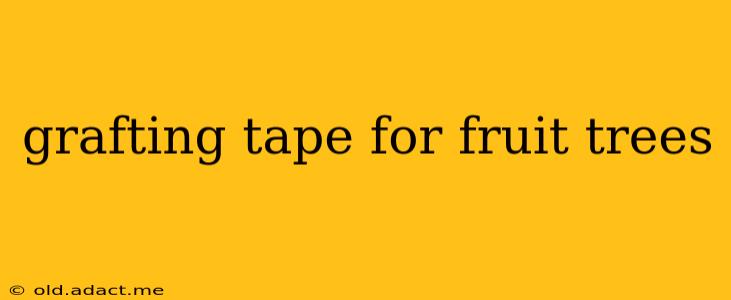Grafting is a fundamental technique in fruit tree cultivation, allowing growers to combine the desirable traits of different varieties. Successfully grafting relies on several factors, with the choice of grafting tape playing a crucial role. This comprehensive guide explores the world of grafting tape for fruit trees, answering your key questions and helping you achieve optimal grafting results.
What is Grafting Tape Used For?
Grafting tape's primary function is to securely hold the scion (the cutting) and rootstock (the base tree) together during the healing process. This crucial step prevents the graft union from drying out, shifting, or becoming dislodged. The tape provides support and protection, allowing the cambium layers of the scion and rootstock to fuse together, forming a strong, unified plant. Without proper taping, the graft union is vulnerable to damage, significantly reducing the chances of a successful graft.
What are the Different Types of Grafting Tape?
Several types of grafting tape cater to different needs and preferences. Choosing the right type depends on factors like the time of year, the type of graft, and personal preference. Common options include:
-
Parafilm M: A flexible, self-sealing plastic film frequently used for smaller grafts. It stretches easily to conform to the graft union, providing a waterproof barrier. Its flexibility is a major advantage, but it can be less durable than other options.
-
Grafting Rubber Tape: A strong, durable rubber tape offering excellent protection against the elements and desiccation. It's often preferred for larger grafts and challenging weather conditions, and it typically provides strong adhesion for the healing process.
-
PVC Tape: A cost-effective option, though often less flexible and less biodegradable than other choices. While effective, it’s crucial to ensure it's not too tight, potentially constricting the growth of the graft union.
-
Biodegradable Tapes: Environmentally friendly options, typically made from natural materials. These eventually decompose, eliminating the need for removal, though they might not offer the same strength and longevity as other tapes.
How to Choose the Right Grafting Tape?
Selecting the appropriate grafting tape hinges on several considerations:
- Type of Graft: The size and shape of the graft union will influence the tape's required flexibility and strength.
- Climate: In harsh weather conditions, a more durable tape is needed to withstand wind, rain, and temperature fluctuations.
- Personal Preference: Some growers favor specific tape types based on their experience and the ease of application.
How Long Should Grafting Tape Stay On?
This is a crucial question. Leaving the tape on for too long can lead to girdling (constricting the growth of the union), while removing it too early can disrupt the healing process. Generally, grafting tape should remain on the graft for 6 to 8 weeks, but it depends on the type of tape and the growth rate of the tree. Observe the graft union carefully; when callus tissue (new growth) is visible, and the union appears well-healed, it's usually time to carefully remove the tape.
Can I Use Regular Tape for Grafting?
While you might be tempted to use readily available tapes, it's strongly discouraged. Regular tapes often lack the necessary flexibility, water resistance, and breathability for successful grafting. They may also leave residue or damage the delicate tissues of the graft union. It’s best to stick to purpose-made grafting tapes for the best results.
What Happens If Grafting Tape is Too Tight?
A common mistake is applying grafting tape too tightly. This restricts the growth of the union, leading to girdling. Girdling can severely inhibit the flow of sap and ultimately kill the graft. Always ensure the tape is snug but not constricting.
When Should I Remove Grafting Tape?
As mentioned previously, the ideal time to remove grafting tape is after 6-8 weeks, or when visible callus tissue indicates a well-healed graft union. Carefully remove the tape to avoid damaging the newly formed tissues. If the tape adheres stubbornly, consider softening it with a little water before removal.
This comprehensive guide provides a solid foundation for understanding the importance of selecting and using the appropriate grafting tape for successful fruit tree grafting. Remember, proper technique and careful observation are key to achieving optimal results and enjoying a bountiful harvest from your grafted trees.
